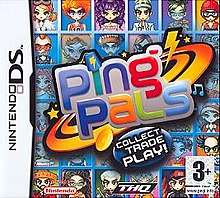Ping Pals
Ping Pals is a chat/accessory program developed by WayForward Technologies and published by THQ for the Nintendo DS. It was released on December 8, 2004 in North America. The program allows the user to customise their "Ping Pal" avatar and game interface by selecting from over 1000 different items such as hairstyles, makeup, clothing, backdrops, music loops and sound effects.
| Ping Pals | |
|---|---|
 | |
| Developer(s) | WayForward Technologies |
| Publisher(s) | THQ |
| Producer(s) | Derek Dutilly |
| Designer(s) | Matt Bozon |
| Programmer(s) | Ian Wakelin |
| Artist(s) | Matt Bozon |
| Writer(s) | Paula Shumard |
| Composer(s) | Shin'en Multimedia |
| Platform(s) | Nintendo DS |
| Release | |
| Mode(s) | Single-player, multiplayer |
Gameplay
Items can be unlocked by trading with other players or buying them in a shop. Players must trade to complete their collections, as each cartridge's shop offers a different subset of the items. Players receive a regular allowance of coins, using the DS' date-keeping functionality, and can get more by playing mini-games (such as Guess the Number and Hot Potato), typing certain secret words in chat (each word works once per file) and even for choosing to display the credits screen more than once.
Up to 16 players can connect wirelessly using one game cartridge; each must be within about 100 feet (30 m) of one of the others to exchange text and picture messages.
Reception
| Reception | ||||||||||||||||||||||||||||||
|---|---|---|---|---|---|---|---|---|---|---|---|---|---|---|---|---|---|---|---|---|---|---|---|---|---|---|---|---|---|---|
| ||||||||||||||||||||||||||||||
Although Ping Pals was marketed as a nonviolent, girl-friendly game, it was frequently criticized as not being interactive enough to be called a game. In addition to this, the DS has a built-in chat program called PictoChat. PictoChat includes features that Ping Pals lacks, and due to this, the game received "generally unfavorable reviews" according to the review aggregation website Metacritic.[1] For instance, Nintendo Official Magazine, in its Nintendo DS special, had the opening sentence saying: "With PictoChat coming as standard, this is a bit like paying money to breathe air." The reviewer gave a one word written summary reading "POINTLESS".[10]
Several images in Ping Pals were licensed from QPlay. These include the Cupimon, a green creature that dances in the startup animation, and several avatar and clothing graphics.
The game received two zeroes and one 1.5 from Electronic Gaming Monthly, the lowest average score in the history of the publication.[3]
See also
- PictoChat
References
- "Ping Pals for DS Reviews". Metacritic. CBS Interactive. Retrieved October 11, 2019.
- Maragos, Nich (January 4, 2005). "Ping Pals". 1UP.com. Ziff Davis. Archived from the original on January 5, 2010. Retrieved October 11, 2019.
- EGM staff (January 2005). "Ping Pals". Electronic Gaming Monthly. No. 187. Ziff Davis. p. 143.
- Navarro, Alex (December 15, 2004). "Ping Pals Review [date mislabeled as "December 16, 2004"]". GameSpot. CBS Interactive. Retrieved October 11, 2019.
- Theobald, Phil (December 17, 2004). "GameSpy: Ping Pals". GameSpy. IGN Entertainment. Retrieved October 11, 2019.
- Zacarias, Eduardo (December 28, 2004). "Ping Pals - NDS - Review". GameZone. Archived from the original on September 28, 2008. Retrieved October 11, 2019.
- Harris, Craig (December 14, 2004). "Ping Pals". IGN. Ziff Davis. Retrieved October 11, 2019.
- "Ping Pals". Nintendo Power. Vol. 188. Nintendo of America. February 2005. p. 115.
- Metts, Jonathan (December 30, 2004). "Ping Pals". Nintendo World Report. NINWR, LLC. Retrieved October 11, 2019.
- "Ping Pals review". Nintendo Official Magazine. Future plc. 2005.
- van Leuveren, Luke (August 27, 2005). "Ping Pals Review". PALGN. PAL Gaming Network. Archived from the original on December 29, 2011. Retrieved October 11, 2019.